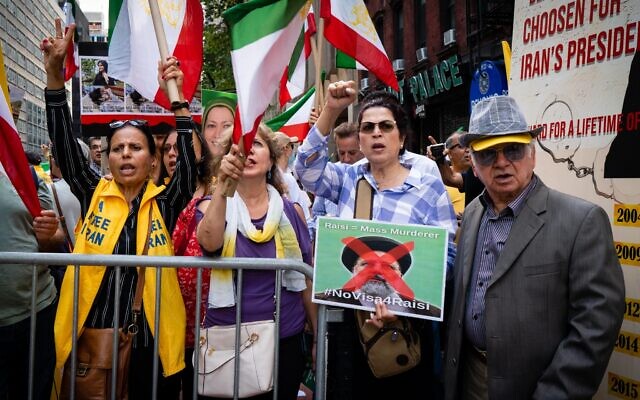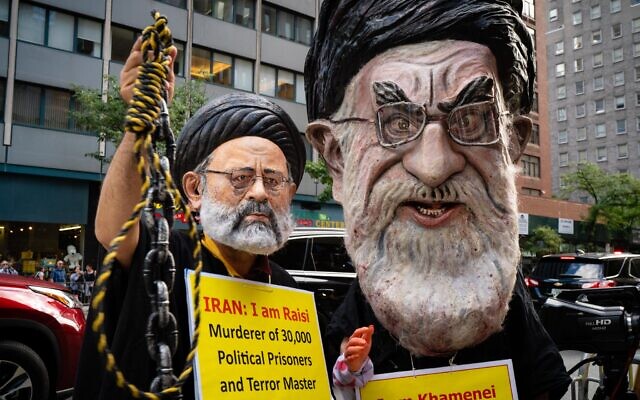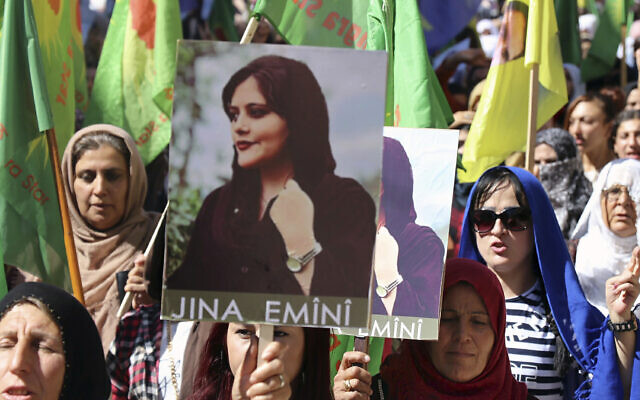This Editor’s Note was sent out Wednesday in ToI’s weekly update email to members of the Times of Israel Community. To receive these Editor’s Notes as they’re released, join the ToI Community here.
Almost two weeks into the latest wave of anti-regime protests in Iran, the long-distance, indirectly informed sense is that they are widespread but sporadic; that they reflect profound opposition to the ayatollahs but are not coherently organized; that they are discomfiting to the regime but are not threatening its rule.
Unlike the 2009 protests, which erupted over the rigging of elections that ensured Mahmoud Ahmadinejad retained the presidency, and drew colossal numbers — hundreds of thousands, or more — into the streets for rallies demanding reform, these are not “political” demonstrations, galvanized by prominent opposition figures. Neither, as far as can be gauged, have they expanded to build on the intermittent protests and union strike actions of recent months and years over Iran’s economic malaise, the regime’s misplaced priorities, and the untenable realities of soaring unemployment and spiking food prices.
Rather, they are directed at the heart of the regime itself — led by women; prompted by the death of a woman, Mahsa Amini, in the custody of the regime’s “morality police”; focused on the regime’s repression of women as symbolized by the requirement that women cover up in public, including by wearing the hijab.
Again in contrast to 2009, when US president Barack Obama praised the “amazing ferment” but firmly ruled out any American encouragement of regime change — “It’s not productive, given the history of US-Iranian relations, to be seen as meddling” — this time some in the international community, led by the US, have been showing solid support for the protesters.
Get The Times of Israel's Daily Edition by email and never miss our top stories
From the UN General Assembly podium last week, US President Joe Biden declared: “Today we stand with the brave citizens and the brave women of Iran who right now are demonstrating to secure their basic rights.”
US Secretary of State Antony Blinken, speaking to reporters Tuesday in Washington, flatly blamed the regime for killing Amini “because of decisions she should be making about what she would wear or not wear.”
The US also said it was doing what it could to counter the regime’s blocking of internet access, by allowing technology companies to “expand the range of internet services available to Iranians,” as a US deputy Treasury secretary put it.
The EU has castigated Iran for its deadly repression of the protests. Germany called in the Iranian ambassador. Iranian opposition groups have organized protests outside Iranian embassies. Solidarity marches with Iran’s women have been held worldwide.

Iranian dissidents protest against President Ebrahim Raisi’s appearance at the United Nations, New York City, September 20, 2022. (Luke Tress/Times of Israel)
Outside the UN last week, as President Ebrahim Raisi was addressing the General Assembly, thousands of anti-regime activists gathered to denounce him and the regime and back the protests. “Raisi does not deserve a seat at the UN and he’s not the president of the people of Iran. Raisi is a mass murderer,” said one activist, Raha Heshmatikhah.
The regime’s response seems to reflect both discomfort and its feeling that it has some room for maneuver — a defensive readiness to give a little ground, followed by a hardening of positions.
Early in the protests, Amini’s death was widely covered in Iran’s tightly controlled media, including on the front pages of its daily newspapers. Raisi called upon authorities to “investigate the cause of the incident with urgency and special attention.” As the days passed, however, the official line hardened, and so did the response of Iran’s security forces. Uncertain as to whether placating the public or opening fire is the wiser response, the regime seems to have decided on the latter.
Definitive numbers are impossible to establish, but state media has confirmed “around 60” deaths in the almost two weeks of protests, with non-governmental groups putting the figure at over 75. Those numbers are similar to the death tolls after three months of 2009’s massively supported protests, though thousands upon thousands were arrested in those 2009 confrontations. In other words, the regime is displaying a greater readiness now than then to resort to shooting its own people dead in the streets.

Iranian dissidents protest against President Ebrahim Raisi’s appearance at the United Nations, New York City, September 20, 2022. (Luke Tress/Times of Israel)
Do the 2022 Mahsa Amini demonstrations, and the regime’s response to them, mark the endlessly anticipated beginning of the end of the regime? Nobody — not abroad, and not inside Iran — can credibly answer that question.
This is a regime that is manifestly struggling to keep its people remotely satisfied. There are overlapping masses of discontent — covering those who oppose everything the leadership stands for, those who blame it for their poverty, those infuriated by its corruption. The sparks of dissent are multiplying, and the regime itself is divided over the grooming of Supreme leader Ali Khamenei’s son Mojtaba as his potential successor — a recipe for deeper chaos.
But as a regime critic told Israeli television in an interview from Tehran on Wednesday, “I am almost positive that the process that has started now will not lead to any revolution in the near future… The regime will put down or restrict the protests with violence.” Nevertheless, he added, “that doesn’t mean the women of Iran will give up on their justified demands.”

In this photo provided by Kurdish-run Hawar News Agency, Kurdish women hold portraits of Iranian Mahsa Amini, during a protest condemning her death in Iran, in the city of Qamishli, northern Syria, September 26, 2022. (Hawar News Agency via AP via AP)
Israel to date has been circumspect as regards the protests. Yair Lapid referenced them in his UN speech, where he linked “a murderous dictatorship” that hates its own people to the regime’s efforts to build the bomb, implying that if the regime can do what it’s doing to its own people, there’s no denying what it would attempt to do to ours. “If the Iranian regime gets a nuclear weapon, they will use it,” he said.
Privately, Israel is doubtless warning afresh that this regime cannot possibly be treated as credible in negotiations on a revived nuclear deal, and must not be empowered and emboldened by any relief in sanctions pressure.
Publicly, sensibly, Israel has not been expressing solidarity with the protesters or encouraging them to step up their opposition. The regime, as is its habit, has been working to suggest that the protests are being fueled by countries hostile to Iran. Official Israeli statements would only play into that narrative.
And besides, as a very wise veteran Iran expert said to me on Wednesday, the Iranian regime is currently doing more damage to itself than Israel could hope for.


